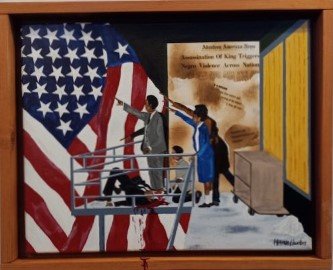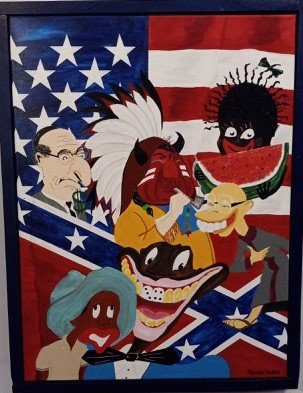Why Black Folks Cry in Church: an interview with artist Herman Houston
Submitted by Barbara Mahoney (‘67)
As a third grader, Herman Houston’s (’67) teacher called his artwork “doodling” but he decided it wasn't doodling if it was his work, he was going to love it and call it art. “I didn’t care what anybody else thought about my work. I didn’t know it at the time, but that attitude has allowed me to relax and enjoy my work without the anxiety of a critical voice. Of course, I have my personal standard, but once I reach that bar I am always pleased with what I’ve painted. When I paint, I only need my own voice to give me validation”.
Herman working in his studio.
“My artistic approach in my current work comes from wanting to elicit an emotional response about our history. Right now, I am working on a ten-painting gallery exhibit Why Black Folks Cry in Church. The series covers signature moments during our civil rights struggle. When completed, I hope my show will be an experience that elicits emotional response. (Even) if someone hates my work, and their blood pressure rises, I am good with that!”
“My first three paintings are powerful from the standpoint that I think it's hard to not have a response. Each of my paintings has a flag in the background. For many, the flag is indeed liberty and justice for all. As a Black American, liberty and justice has often made me feel like I am chasing a carrot dangled in front of me.”
“Pulling Together, the first in the series, depicts a Black man being lynched. I remember when I was in elementary school seeing a picture of a lynching and there was a little girl about eight years old looking at the picture. I used to wonder about that little girl. The challenge for me was to show the horror and the lack of humanity. Hands are pulling the rope but what you don’t see are the faces. That action is horrific and says a lot about America and is something some people have not processed.
‘'Pulling Together” Herman Houston (‘67)
This series is an opportunity look at (that) horror and process it. For me, I did that when I was in elementary school, and as an adult looking at it again might hopefully bring some reflection”.
“Lorraine is my take on that famous photograph just after Martin Luther King, Jr. was murdered. Everybody standing on the balcony of the Lorraine Motel pointing in the direction of the shot. I have the people pointing at the American flag because the flag represents unkept promises. King’s efforts were about building a shared consciousness of the meaning of ‘life, liberty, and the pursuit of happiness’. Again, what has happened has happened and it's an opportunity for reflection”.
“Lorraine” Herman Houston (‘67)
“The third painting, Depictions represents the caricatures that were so prominent when I was young: the Jewish man with a large nose, the exaggerated American Indian, the Chinese man with big buck teeth, and the Black child eating watermelon. I remember my classmates laughing at these images. I never thought of them as funny. It was hurtful but nobody dealt with your hurt back then, so feelings were just tucked deep inside. Now that I can paint my feelings, there’s a sense of freedom I enjoy that cannot be threatened”.
“Depictions” Herman Houston (‘67)
“Democracy, my current painting. depicts a March in Memphis where expressionless Black men are marching with signs that say, “I am a man”. The National Guard threatens with bayonets pointed at the marchers. Again, the background is an American flag. When I was young, I feared the sharp points on those bayonets more than the bullets that came out of the guns. I celebrate the fact that I can have a medium where I can share some of the things that were part of my life without feeling diminished”.
“The Emmett Till painting that I'm planning will be displayed horizontally so viewers will feel like they are beside his casket”.
“The only person who said I could probably be an artist was Mr. (Frank) Fuji (a beloved Franklin art teacher who was my summer school art teacher. Being an artist was a skill that stayed packed away while I worked to have a career and then I was a dad with three sons and a daughter. I'm just now cracking the shell and coming out to be an artist at work. It's an exciting time for me.”





